![]() Pre-lab Questions
Pre-lab Questions
![]() Experiment
Experiment
![]() Post-lab Questions
Post-lab Questions
EXPERIMENT 17: OXIDATION - REDUCTION
The following preparatory questions should be answered before coming to class. They are intended to introduce you to several ideas important to aspects of the experiment. You must turn-in your work to your teaching assistant before you will be allowed to begin the experiment. Be sure to bring a calculator and paper to laboratory.
l. Define the following terms.
(a) oxidizing agent
![]()
(b) reducing agent
![]()
(c) oxidation
![]()
(d) reduction
![]()
2. Given that the following three reactions occur in the direction written;

![]()
![]()
Complete the table.
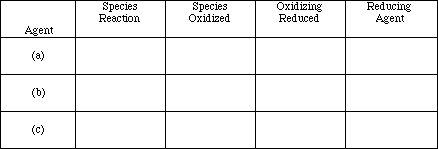
![]()
Rank the strength of the oxidizing and reducing agents identified in the table.
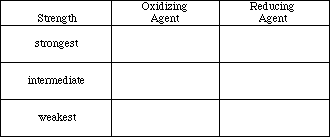
![]()
![]()
EXPERIMENT 17: OXIDATION - REDUCTION
![]() Top
Top
EQUIPMENT:

PART I: Constructing a Qualitative Potential Series (WORK IN PAIRS)
![]()
Using a 24-well plate, half fill two wells each with Cu2+, Pb2+ and Zn2+ solutions. Be sure
to note the location (well number) of each solution. To each of the wells add a shiny piece of Cu, Pb
or Zn metal to form all of the combinations listed in Table I. (If necessary, shine the metal pieces
with steel wool or sand paper.) Complete the table by describing your observations and writing
balanced chemical equations for each reaction you observe. If no reaction occurs, write NR.
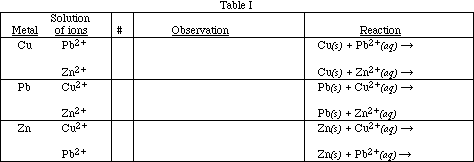
Based on your observations answer the following questions. Remember to always show the charge on the ions.
I. (a) Prepare a potential series for Cu, Pb and Zn and their ions.

(b) Which metal ion is the strongest oxidizing agent?
(c) Which metal ion is the weakest oxidizing agent?
(d) Which metal is the strongest reducing agent?
(e) Which metal is the weakest reducing agent?
![]()
![]()
Using clean wells on the 24-well plate, half fill three wells with 6 M HCl. Scrub pieces of Cu, Pb and Zn metal carefully with steel wool. Do not touch the clean metal surfaces with your hands. Use forceps or a paper towel. To each of the three wells add a different metal piece. Complete the Table II by describing your observations and writing balanced chemical equations for each reaction you observe. If no reaction occurs, write NR. (Note: Some of the reactions may occur very slowly. Allow at least five minutes before deciding that no reaction has occurred.)
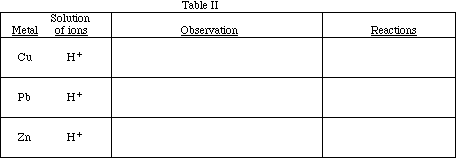
![]()
(g) Position H2 - H+ in the potential series prepared in I (a).
![]()

![]()
![]()
EXPERIMENT 17: OXIDATION - REDUCTION
EQUIPMENT:

PART II: Semi-Micro Voltaic Cells
Cut four Styrofoam coffee cups about 2 cm from the bottom to form shallow cups.
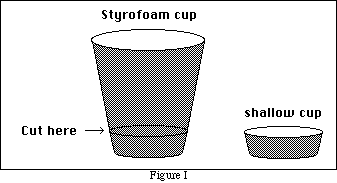
Tape the bottom of one of the cups to the center of a piece of cardboard or stiff paper. Tape the remaining three cups around the center cup as shown in Figure II.

![]()
![]()
Fill the center cup about half full of 1.0 M NH4NO3 solution (5 to 10 mL). Be careful not to splash any solution into the surrounding cups. Fill one of the surrounding cups about half full of 0.1 M CuSO4. Half fill another with 0.1 M FeSO4 and the third with 0.1 M ZnSO4. Label the cups by writing the name of each solution on the cardboard sheet.
Using sandpaper or steel wool, polish copper, zinc and iron electrodes until they shine. Do not handle the electrodes with your fingers, use forceps or paper towels.
Carefully dip one end of the copper electrode in the copper (II) sulfate solution in the cup. Bend the electrode or use small pieces of tape as necessary to secure the electrode to the cup so that one end is below the surface of the solution and the other extends out of the cup (see Figure III).

Repeat the process placing the zinc electrode in the zinc sulfate solution and the iron electrode in the ferrous sulfate solution. Label each cup by writing on the cardboard.
![]()
Fold three sheets of filter paper into strips about 1 cm wide and several layers thick.

Bend one of the strips into a 'U' shape. Invert the 'U' and submerge one end of the strip in the ammonium nitrate solution in the center cup and the other end in the solution in one of the surrounding cups. Repeat the procedure with the remaining two surrounding cups so that each of the three surrounding solutions is connected to the center solution by a strip of filter paper. These connections form a salt bridge between any two of the surrounding cups.
![]()
![]()
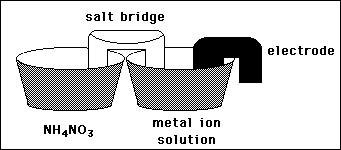
Connect one of the leads of the voltmeter (be sure your voltmeter is set on the 5 or less volt scale) to the copper electrode with an alligator clip. Connect the other lead to the zinc electrode. Read the voltage on the voltmeter scale. If the deflection is negative, remove the clips and attach them to the opposite electrodes. Wait a few seconds for the reading to stabilize and then record the potential.
Obs. #1
![]()
The cathode will be attached to the red pole of the voltmeter and anode to the black.
Which electrode is the anode?
Obs. #2
![]()
Which electrode is the cathode?
Obs. #3
![]()
Write the half reaction occurring at the anode. Is this oxidation or reduction?
Obs. #4
![]()
Write the half reaction occurring at the cathode. Is this oxidation or reduction?
Obs. #5
![]()
Write the overall reaction for the cell.
Obs. #6
![]()
![]()
Record the information (Obs. #1 - #6) for the zinc and copper cell in Table I. Complete the table by measuring the potential of each voltaic cell by attaching the voltmeter lead clips to each combination of electrodes producing a positive voltage.
![]()
Table I
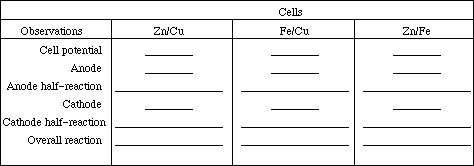
![]()
Based on the measured cell potentials, prepare a potential series similar to that obtained in
Part I of this experiment. List the metals from strongest to weakest reducing agent.and the metal
ions from weakest oxidizing agent to strongest.
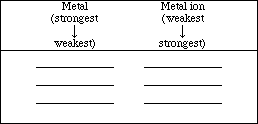
![]()
Compare this result with that obtained in Part I. The only new metal tested this time is
iron. Can you insert Fe into the series generated in Part I? Explain your answer.
Expl. #1
![]()
![]()
Replace the voltmeter leads on the copper and zinc electrodes to give a positive cell potential. Using forceps, remove the strips of filter paper connecting the copper(II) solution to the NH4NO3 solution. Describe what happens.
Obs. #7
![]()
What is the purpose of the salt bridge? For the zinc/copper cell, in which direction do ions
move from the center NH4NO3 solution?
Expl. #2
![]()
Replace the filter paper strip. Measure and record the cell potential in Table II. Add some
(2-3 mL) 6 M NH3(aq) to the cup containing CuSO4. Observe and record the cell potential. (The
deep blue color is due to the formation of Cu(NH3)42+ complex.)
![]()
Now add some (2-3 mL) 2 M Na2S to the copper solution. Measure and record the cell
potential.

![]()
Explain the changes in the cell potential caused by the addition of NH3(aq) and Na2S.
![]()
Expl. #3
![]()
![]()
To clean up, remove the electrodes and filter paper strips from the cups. Carefully lift each cup, and slide one finger underneath to detach the cup from the tape. Dispose of the solutions as directed by your instructor. Clean and dry the electrodes and return them to their labeled containers. Place the filter paper strips in the trash.
![]()
![]()
EXPERIMENT 17: OXIDATION - REDUCTION
EQUIPMENT:

PART III: Electrolysis of a Sulfuric Acid Solution
Clean a copper electrode by scrubbing it with steel wool until all surfaces shine. Rinse the
electrode thoroughly with water and wipe with a paper towel to remove any material clinging to the
metal. Rinse the electrode with a small amount of acetone and allow it to air dry. When the
electrode is dry weigh it on the laboratory balance (handle the dry electrode only by the edges or
use forceps) and record the initial mass in observation 1.
Obs. #1
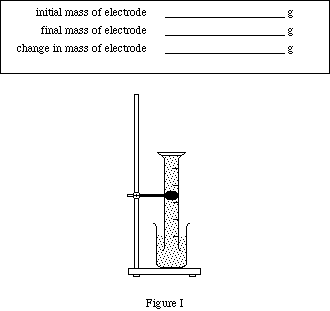
Pour about 100 mL of 1 M sulfuric acid into a 250 mL beaker. Fill a 50 mL graduated cylinder level full with the same acid solution. Very carefully cap the graduated cylinder with a small square of parafilm. Invert the cylinder and place it in the beaker so that its mouth is below the level of the acid but not touching the bottom of the beaker. Clamp the graduated cylinder to a ring stand
![]()
![]()
to hold it in place. Remove the parafilm below the surface of the acid solution using forceps. There should be no air bubbles inside the graduated cylinder.
Obtain a long piece of insulated wire with exposed wire ends. Coil the longer exposed end around a pen or pencil. About 2 cm below the coil, bend the wire as shown in Figure II.

Place the coiled end of the wire in the beaker. Maneuver the wire so that the coil and all uninsulated wire is inside the graduated cylinder. (See Figure III)
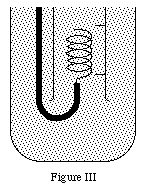
Bend the wire down the side of the beaker to hold it in place. Attach the free end of the wire to the negative terminal of a 9 volt battery. Obtain an insulated wire with alligator clips on either end. Attach one clip to the positive terminal of the battery and the other to a copper electrode. In a moment the end of this copper electrode will be placed in the beaker containing the solution of sulfuric acid. Before placing the electrode in the beaker, put a sheet of white paper under the beaker.
Record the exact time when you dip the copper electrode into the solution in the beaker.
Obs. #2

![]()
![]()
Your experimental set-up should resemble Figure IV.
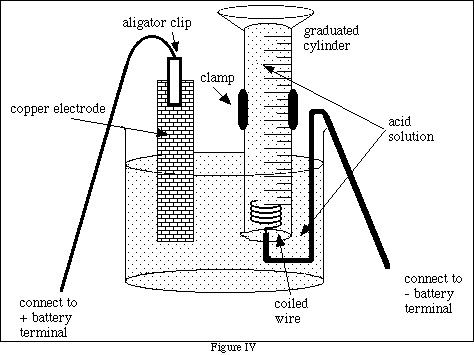
Position the wire so that the electrode remains partially submerged in the solution. Do not allow the alligator clip to contact the solution. Observe and record what happens when the electrode enters the solution and as the reaction progresses.
Obs. #3
![]()
While the reaction progresses, measure the temperature of the solution and the atmospheric
pressure. Record the values below.
Obs. #4

![]()
![]()
Allow the reaction to continue until about 45 mL of gas are collected in the graduated cylinder. Then remove the copper electrode, being careful to record the exact time in Obs. #2. What happens when the electrode is removed from the solution?
Obs. #5
![]()
Rinse the electrode thoroughly with water and wipe it with a paper towel to remove any
solid that may adhere to the surface. Rinse the electrode with acetone and allow it to air dry.
When dry, weigh the electrode on the laboratory balance and record the final mass in Obs. #1.
Determine the change in mass of the electrode.
Remove the coiled wire from the graduated cylinder and beaker. Raise or lower the cylinder so that the water levels inside and outside the cylinder are equal. If this is not possible because the solution level inside the cylinder is much higher than the level outside, lower the cylinder until its mouth almost touches the bottom of the beaker. Add water to the beaker until the water levels inside and outside the graduated cylinder are equal. Read the volume of gas in the cylinder. Remember that the scale on the cylinder is upside down! Record the volume below.
Obs. #6
![]()
We know that this gas has been generated at the negative electrode, but we do not know its chemical identity. To determine its identity we must examine its physical properties. Describe the appearance of the gas below.
Obs. #7
![]()
Consider that the gas is generated from an aqueous solution of H2SO4. The gases generated from
such a solution are H2 or O2. Does the description in Obs. #7 help to determine which of these
gases has been generated? _______________
One property that hydrogen and oxygen do not share is flammability. When exposed to an open flame hydrogen explodes while oxygen simply makes the flame glow more brightly.
Raise the graduated cylinder out of the beaker, allowing the water to fall back into the beaker. Clamp the graduated cylinder, still inverted in the air well away from all equipment. HAVE YOUR INSTRUCTOR pass a lit match near the opening of the cylinder. If hydrogen is present an explosion (really just a small pop) will occur. Describe the result.
Obs. #8
![]()
![]()
Identify the gas formed and write a half reaction representing the process. Is the reaction which produces the gas an oxidation or reduction reaction? Name the electrode (anode or cathode) at which it occurs.
Obs. #9
![]()
Name (anode or cathode) the positive electrode and write the reaction that occurs there. What
evidence do you have to support the reaction you have written.
Obs. #10
![]()
![]()
Calculations:
1. In addition to the gas generated in the chemical reaction the graduated cylinder also contains water vapor. In order to find the partial pressure of the gas we use Dalton's Law of partial pressure.
Ptotal = Pgas + Pwater vapor
![]()
Look up the vapor pressure of water at the temperature of your solution in your text, in the
CRC handbook, in another reference book. Calculate the partial pressure of the gas
generated.
![]()
2. Using Obs. #4 and #6 complete the table. Show any necessary unit conversions.
Pressure __________ atm
Volume __________ L
Gas Constant __________L-atm/mol K
Temperature __________ K
![]()
3. Use the ideal gas law to calculate the number of moles of gas generated.
![]()
4. Calculate the number of moles of Cu metal lost by the copper electrode.
![]()
![]()
5. (a) Write the oxidation half reaction occurring at the anode.
![]()
(b) Write the reduction half reaction occurring at the cathode.
![]()
(c) Write the overall balanced chemical reaction.
![]()
6. Compare the results of problems 3 and 4 with the equation obtained in 5(c). Is the mole ratio
what is predicted by the equation? Calculate the percent error.
![]()
7. Calculate the number of moles of electrons used in the experiment.
![]()
8. Use Faraday's constant to calculate the number of coulombs of current used in the
experiment.
![]()
9. Determine the number of seconds elapsed during the experiment.
![]()
![]()
10. Calculate the current in amperes produced by the battery (1 Amp = 1 coulomb/sec). Compare your result with those of other students or groups. Is the current output constant for all 9 volt batteries?
![]()
Questions:
1. Will the reaction performed in this experiment proceed without the battery? Explain your answer.
![]()
2. A color change is observed in the solution as the reaction progresses. What is the significance
of the color?
![]()
3. Why is it necessary to adjust the level of the solution inside the graduated cylinder to equal the
level of the solution in the beaker before reading the volume of gas in the cylinder?
![]()
4. Consider the error determined in calculation #6. Discuss the sources of error in the
experiment, excluding human errors.
![]()
![]()
![]()
Answer the following questions after you have completed all parts of the oxidation-reduction
experiment.
![]()
1. Describe the differences and similarities between voltaic and electrolytic cells.
![]()
2. Suppose that you needed to construct a temporary battery to power a small lamp. Using any
materials available in this experiment (excluding the 9 volt battery in Part III, of course!)
how would you proceed?
![]()
3. An electrolytic cell, like the one used in Part III of this experiment was found to produce gas
very very slowly. In order to speed up the process, a Chemistry student proposed using
concentrated (18 M) sulfuric acid rather than the 1M acid called for in the experiment.
(a) Would the student's suggestion be effective? Why?
![]()
(b) Suggest a method of increasing the reaction rate and tell how your method would work
![]()
4. Locate the "NR" observations recorded in Table I of Part I of this experiment. Is it ever
possible for these combinations of chemicals to react? If so, explain the circumstances under
which reactions could occur. If not, explain why not.
![]()
Contents
![]() Return to
Return to![]() Index of Experiments
Index of Experiments![]() Pre-lab Questions
Pre-lab Questions
![]() Experiment
Experiment
![]() Post-lab Questions
Post-lab Questions
![]() Top
Top
![]()